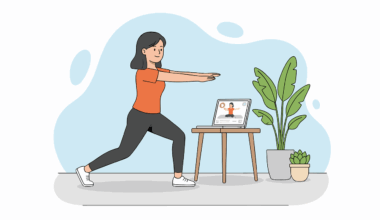Building Confidence to Improve Safety Inline Skating
Inline skating can be an exhilarating activity, but with excitement comes the need for safety. Every skater, especially beginners, must prioritize their safety to ensure a positive experience. Start by investing in quality protective gear, as this is crucial for injury prevention. A properly fitted helmet is essential to protect your head in case of falls. In addition to a helmet, consider wearing knee pads, elbow pads, and wrist guards, as they provide critical protection against scrapes and bruises. To further enhance safety, make sure that your skates are appropriate for your size and skill level. Properly maintaining your skates ensures they perform effectively on various surfaces. Regularly check wheels and bearings to guarantee smooth and safe gliding. Furthermore, remember to warm up before hitting the pavement or the rink properly. Warm muscles and joints can significantly reduce the risk of injuries. Always skate in designated areas and be aware of your surroundings. Learning basic skating techniques can also boost your confidence, allowing you to navigate different terrains safely. Focus on balance and braking skills for improved control while skating.
Confidence comes with practice, so start slowly as you develop your skills. Choose flat and smooth surfaces for initial practice, ensuring that you have ample room to maneuver without obstacles. As you grow more comfortable on your skates, gradually introduce yourself to more challenging environments. It’s essential to skate with friends or experienced skaters, as this not only enhances your learning experience but also increases safety. They can provide valuable tips and encouragement, building your confidence as you learn. When practicing, pay attention to your body alignment; keeping your knees slightly bent and your back straight can enhance your stability. Confidence also stems from understanding how to fall safely. Instead of bracing for impact with your hands, practice rolling onto your side or hip to minimize injury. Moreover, consider enrolling in classes or joining a skating club for professional guidance and support. These resources can provide structured learning and promote safety awareness. Remember, injuries often occur due to panic or inexperience, so focus on enjoying the learning process instead of rushing to master tricks. Building confidence takes time, but with steady progress, you will feel secure and enjoy inline skating.
Understanding the Importance of Safety Gear
Understanding the different types of safety gear is vital in reducing the risk of injuries while inline skating. Each piece of equipment plays a unique role in protecting various body parts, especially for beginners. Helmets are the most vital gear, ensuring proper protection of the skull. Ensure you choose a helmet that meets safety standards and is comfortable to wear. Knee pads are essential as they absorb the impact during falls, reducing the severity of wrestles and damage. Properly fitted knee pads will stay in place during use, providing maximum support. Elbow pads are similarly important, offering protection to these vulnerable joints while skating. They prevent scrapes and cuts when skating on uneven surfaces. Wrist guards are crucial for safeguarding wrists, particularly since many skaters instinctively use their hands to break a fall. Always make sure they fit snugly but are not too tight to restrict movement. In addition to these common items, consider additional pads or protective suits for extra safety, especially for more adventurous activities. Investing in protective gear is an essential step towards enhancing confidence while skating and ultimately enjoying the sport to its fullest.
The environment where inline skating takes place can impact safety. Always scout for smooth, maintained paths free from debris, potholes, or any hazards. Participating in this activity in crowded areas substantially increases the risk of collisions. Ensure that the paths you choose are specifically designed for skating, as these spaces are generally safer and more accommodating. Weather is also an important factor to consider; wet surfaces can be particularly dangerous. Skating on wet pavement reduces control and can lead to unexpected slips, which can increase the likelihood of falling. Plan your skating sessions in dry, sunny weather whenever possible. When skating outdoors, remain aware of your surroundings and be considerate of pedestrians and cyclists. Skaters should maintain a safe distance and communicate clearly when passing others. If you’re skating on the street, follow all traffic laws and signals for utmost safety. It’s advisable to wear bright or reflective clothing, especially when skating in low light conditions, as this increases visibility. Staying cautious and aware of your environment fosters a safer experience for you and those around you.
Developing Balance and Control
Improving balance and control is integral to gaining confidence while inline skating. The better your balance, the safer you will be. Start with fundamental drills that enhance your stability. Practice skating in a straight line at a slow speed before gradually increasing your pace. Focus on maintaining a low center of gravity by bending your knees. This posture will help you stay grounded and more prepared to correct wobbles or slips while skating. Incorporating simple turns into your practice can also boost your confidence. Focus on shifting your weight properly from one foot to another to execute smooth turns without losing control. Consider using a wall or rail for support at first until you feel confident enough to try making turns independently. Practice “t-stops,” a brake technique that can help you gain control when decelerating or stopping. The key to feeling safe in any skating environment is understanding how to control your movements effectively. Additionally, consider practicing skating backwards to enhance your skills further; this improves awareness and keeps your balance challenged. As you achieve mastery of basic maneuvers, you will feel more confident taken on intermediate to advanced skating techniques.
Taking time to learn and practice necessary skills is essential for inline skating. Incorporate different drills into your practice routine to challenge yourself and improve overall skills. For instance, focus on stopping effectively, as this is crucial to ensuring safety while skating. Learning to employ the “Hockey Stop” or “Plow Stop” techniques can give you the control necessary to halt quickly when the need arises. Additionally, practicing slalom movements can enhance your agility and balance. Set up cones or markers on a flat surface and navigate between them, which will train your body to maneuver effectively around obstacles. As you grow more comfortable with the basic movements, consider introducing small jumps or tricks into your routine to further build confidence. However, it’s essential to only attempt these on safe, designated areas designed for such activities. Skating when feeling fatigued can increase the chance of accidents due to lack of concentration. Therefore, always listen to your body and take breaks when necessary. Hydration is also essential in maintaining focus and energy levels, leading to a safer and enjoyable skating experience overall.
Establishing a Skating Community
Joining or forming a skating community can considerably boost your confidence while ensuring safety. Surrounding yourself with like-minded individuals encourages skill development and provides an opportunity to learn from each other. With a supportive network, you can share experiences, learn new techniques, and practice together in a safe environment. Consider finding local skating groups on social media platforms or community boards; these groups often organize events, workshops, or group skating sessions. Participating in such events can deepen your understanding of skating, while creating a lively atmosphere where you feel at ease. Furthermore, skating with others provides an extra layer of safety, as you are less likely to encounter hazards alone. This will reduce the risk of accidents significantly. Engaging with seasoned skaters offers practical insights, which fosters personal growth in skating skills. As you create connections with fellow skaters, these friendships often lead to life-long bonds. Group activities also introduce fun challenges and competitions to keep training exciting. By establishing a skating community, you foster accountability while ensuring a safer and more gratifying experience in inline skating.
In conclusion, enhancing safety and building confidence in inline skating is a proactive process. It involves combining protective gear, environment awareness, technical skills training, and community engagement. Always prioritize personal safety and the well-being of others while skating. Regular practice of the skills you learn will eventually make you feel more comfortable and confident. Remember, the journey of improvement takes time, so keep a positive attitude and remain patient as you learn. Understanding how to fall, build balance, and control your movements effectively will significantly contribute to your enjoyment of inline skating. Additionally, surrounding yourself with a supportive community can be immensely beneficial as you navigate the various challenges you may face. Embrace the process of learning and celebrate small victories along the way. Each time you lace-up your skates, remember that building confidence is a gradual but rewarding journey. It will enable you to enjoy skating fully while improving your skills. Be open to feedback from other skaters, as constructive criticism helps you grow. With every outing, continue to refine your technique while enjoying the thrill of inline skating.


